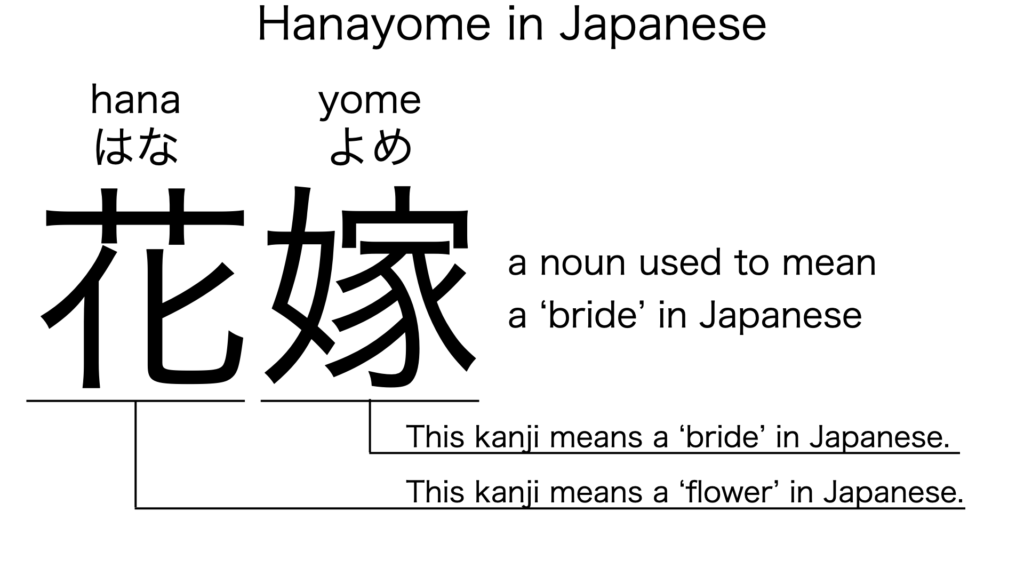What does “hanayome” mean in Japanese?
Native speakers use hanayome to mean a ‘bride’ in Japanese. Perhaps, some Japanese learners know this word as it is sometimes used in Japanese movies, novels, manga, anime, and the like. In this blog post, however, I’m explaining this word in detail based on its kanji expression. And also, I’m explaining how to use it through example sentences. My explanations would help Japanese learners understand hanayome more clearly. Then, let’s get started!
Contents
Definition and meanings of “hanayome”
Let me start with the definition and meanings of hanayome.
- hanayome – 花嫁 (はなよめ) : a noun used to mean a ‘bride’ or more specifically a ‘bride on the marriage day’ in Japanese. This can also work as plural. Learn more about Japanese plural.
The definition and meanings are not that difficult, I think. To understand this noun more clearly, however, let me explain its kanji characters in detail, one by one.
Hanayome in kanji
The kanji expression of hanayome consists of the following two kanji characters:
- 花 : a kanji character often used to mean a ‘flower’ in Japanese.
- 嫁 : a kanji character often used to mean a ‘bride’ or ‘wife’ in Japanese.
From these two kanji characters, we can understand that hanayome literally means a ‘flower bride’ in Japanese. This literal interpretation is not completely in line with the actual meanings, but still very understandable, I think. Brides are often beautiful like flowers.

When we meet new kanji expressions, we should check their kanji characters in detail to understand their meanings clearly and deeply. In many cases, kanji characters tell us a lot about the meanings of the expressions they form. Actually, here, we could get the better understanding of hanayome through the detailed kanji check above.
So far, I’ve explained the definition and meanings of hanayome together with its kanji characters. Then, let me explain how to use it through the example sentences below.
How to say “bride” in Japanese
kanojo ga hanayome desu – 彼女が花嫁です (かのじょがはなよめです)
She is the bride.
Below are the new words used in the example sentence.
- kanojo – 彼女 (かのじょ) : a pronoun used to mean ‘she’ in Japanese.
- ga – が : a case particle used to make the subject word or the object word in a sentence. In the example, this is used after kanojo to make the subject in the sentence.
- desu – です : an auxiliary verb used after a noun or adjective to make it polite. Probably, this is well known as a part of the Japanese desu form. In the example, this is used after hanayome to make it sound polite.
This is a typical usage of hanayome. In this example, it works as the complement in the sentence.
Another example of “hanayome”
「hanayome wa totemo kirei desu」 to kare ga it ta – 「花嫁はとても綺麗です」と彼が言った (「はなよめはとてもきれいです」とかれがいった)
“The bride is very beautiful,” he said.
Below are the new words used in the example sentence.
- wa – は : a binding particle working as a case marker or topic marker. In the example, this works after hanayome to make the subject in the clause.
- totemo – とても : an adverb of degree meaning ‘very’, ‘much’, ‘so’, or such in Japanese. In the example, this works in front of kirei to emphasize its meaning.
- kirei – 綺麗 (きれい) : the stem part of the na-adjective, kireina, which means ‘beautiful’ in Japanese.
- to – と : a case particle used as a quote marker in Japanese. In the example, this is used after the quote to indicate what he said.
- kare – 彼 (かれ) : a pronoun used to mean ‘he’ in Japanese.
- it – 言っ (いっ) : one conjugation of the verb, iu, which means ‘to say’ in Japanese. In the example, it has been conjugated for the better connection with its following word.
- ta – た : an auxiliary verb used after a verb, adjective, or auxiliary verb to make its past tense form. Probably, this is well known as a part of the Japanese ta form. In the example, this is used after it to make its past tense form, it ta, which means ‘said’ in Japanese.
This is another example of hanayome. In this example, it works together with the binding particle, wa, to become the subject in the clause. When we want to mean a ‘bride’ in Japanese, anyway, this noun is always a very good option.
Summary
In this blog post, I’ve explained the definition and meanings of hanayome in detail based on its kanji expression. And also, I’ve explained how to use it through the example sentences. Let me summarize them as follows.
- hanayome – 花嫁 (はなよめ) : a noun used to mean a ‘bride’ or more specifically a ‘bride on the marriage day’ in Japanese. This can also work as plural. These two kanji characters literally mean a ‘flower bride’ in Japanese. This literal interpretation is not completely in line with the actual meanings, but still very understandable, I think. Brides are often beautiful like flowers.
Hope my explanations are understandable and helpful for Japanese learners.
Leave a Reply